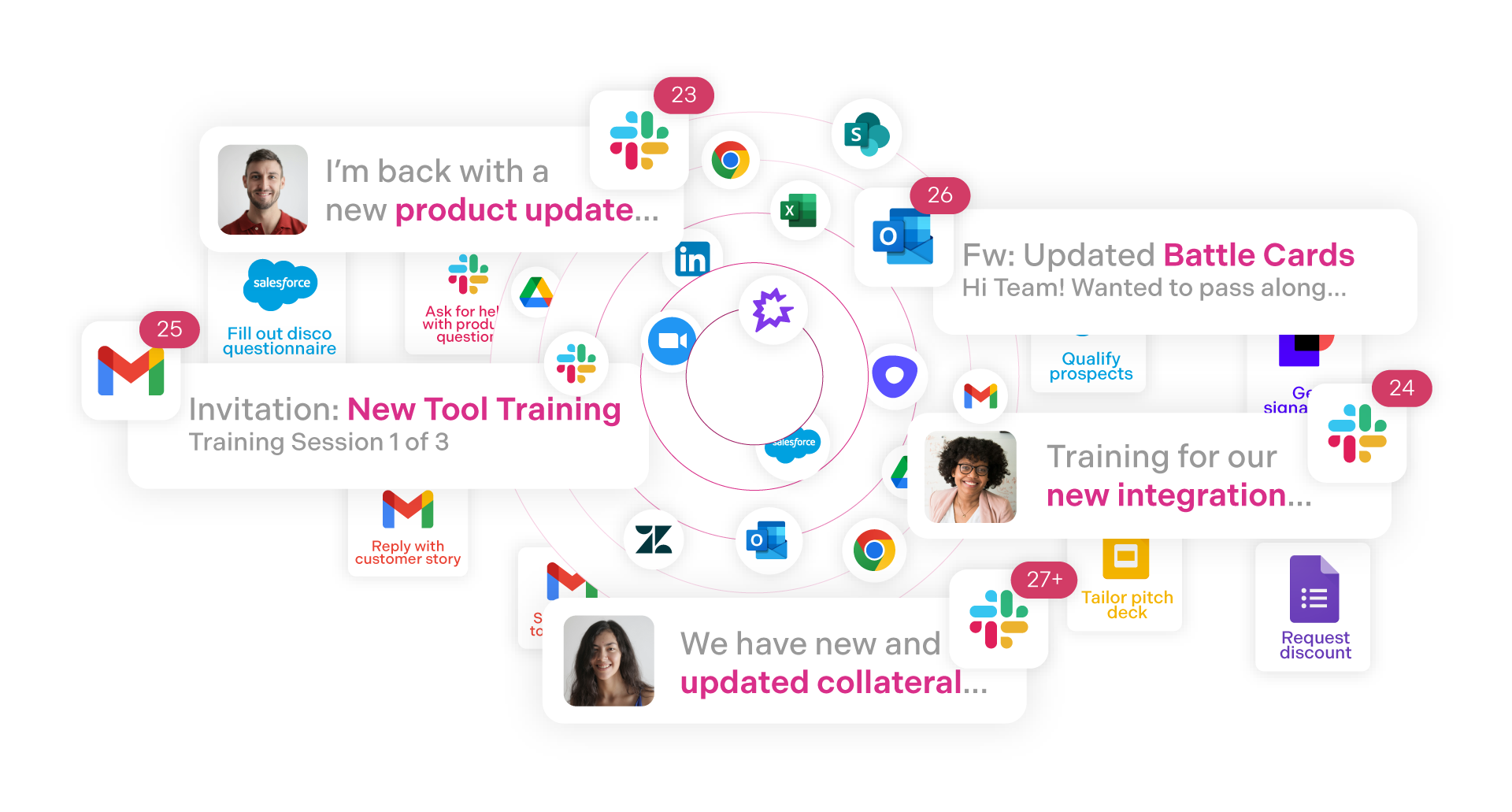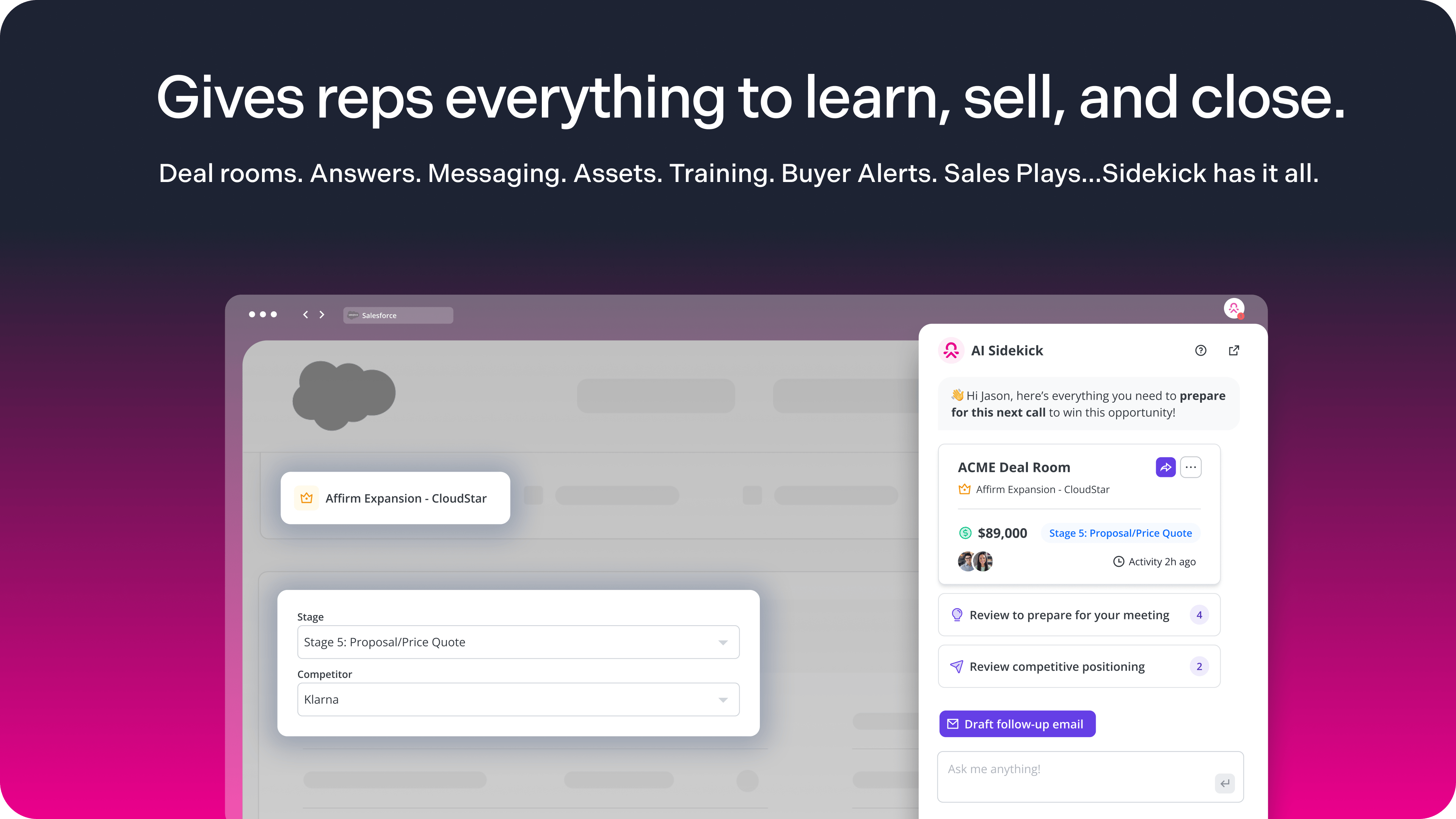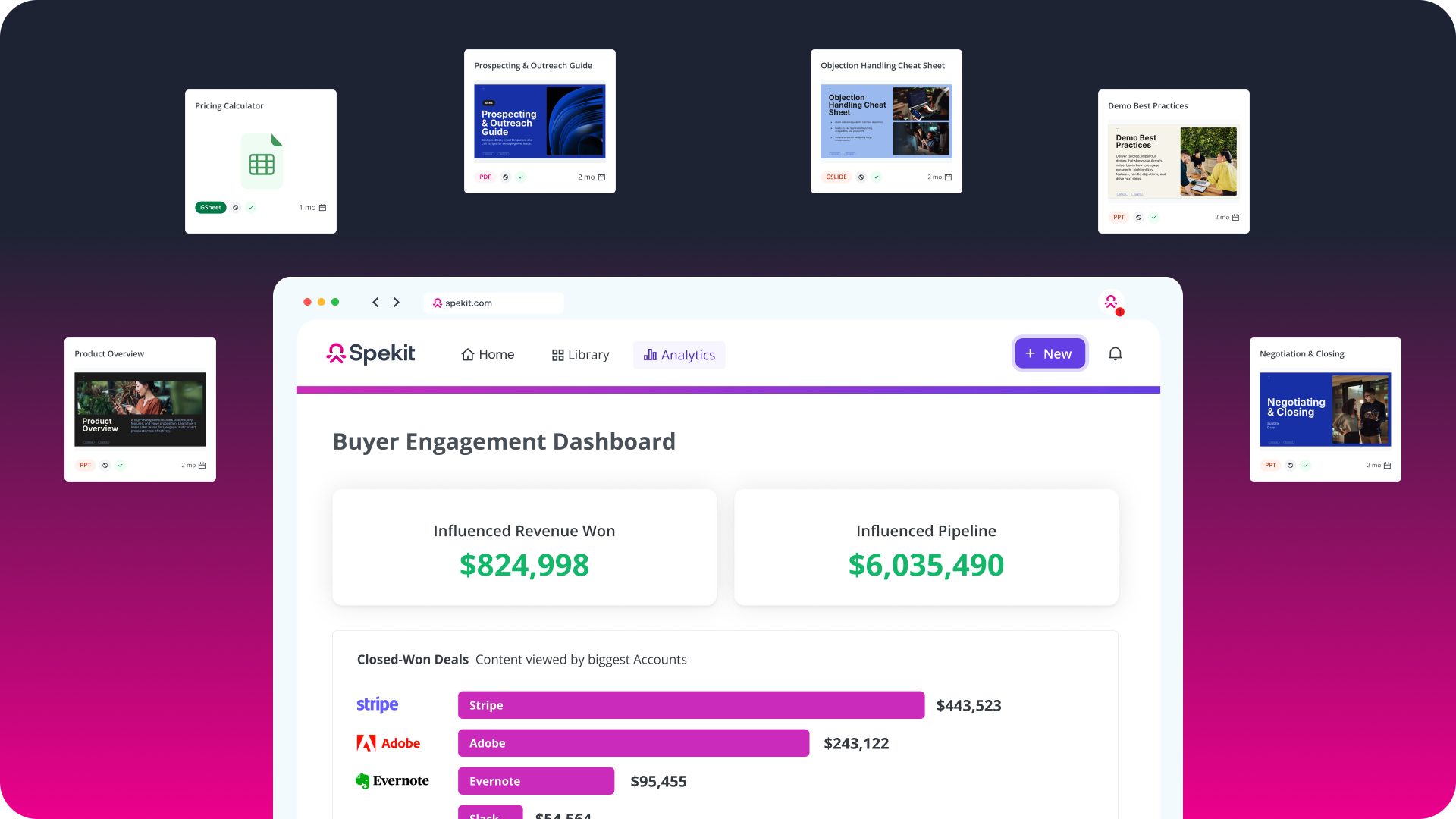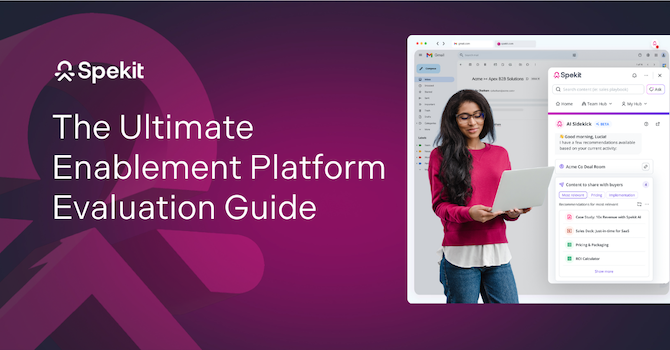Sales enablement software is no longer a “nice-to-have.” It’s a revenue-critical system that drives adoption, accelerates ramp, and connects content to measurable outcomes. In fact, over the last five years, sales enablement trends show the function’s adoption has surged by an impressive .
This is no surprise since companies implementing sales enablement gain a – compared to 42.5% for those that don’t employ such strategies. Also, when organizations adopt a top-tier sales enablement approach, an impressive 84% of sales representatives consistently meet their sales quotas.

Yet many teams still struggle to realize that impact. The Impact of Enablement 2025 report shows budgets are steady or rising for most teams, but adoption lags. Many sales leaders log into their enablement platform fewer than five times per quarter, and a large share of content is outdated or unused. The result is wasted spend, fragmented workflows, and missed revenue.
What is sales enablement?
So, what is sales enablement?
It’s the discipline of equipping revenue teams with the right knowledge, content, and guidance, delivered at the moment of need, so every rep can execute with clarity and consistency.
In 2025, that means unifying content management and learning, then delivering them directly in Salesforce, Gmail or Outlook, Slack, and call tools. The bar is “search-to-answer in under 30 seconds” and content that stays accurate by design.
Sales enablement has changed in three big ways.
First, it has moved from portals to in-flow delivery; instead of asking reps to hunt in separate dashboards, guidance appears where work happens.
Second, it has shifted from static to dynamic; AI detects decay, flags duplicates, and proposes updates so content stays trusted.
Third, it has moved from usage to outcomes; leaders connect enablement activity to pipeline movement, win rates, and time to close.
The core idea from the book Just-in-Time: Enablement in a World of AI is simple: the future isn’t more content — it’s faster access to fewer, better answers, delivered precisely when the rep needs them.
Why is sales enablement important?
Modern programs matter because they bridge marketing, enablement, and sales to deliver measurable impact.
Teams see faster ramp through contextual onboarding and micro-reinforcement, higher adoption because guidance lives in the workflow, consistent messaging from a governed content layer, shorter cycles as reps answer objections and share proof in seconds, and clear ROI as insights tie enablement activity to opportunities and closed-won revenue.
Reducing turnover: stronger onboarding and in-flow support cut time-to-confidence and attrition.
Boosting productivity: cut hours of weekly searching by surfacing answers directly in CRM, email, and call tools.
Accelerating cycles: timely talk tracks, proof, and next steps speed decisions.
Ensuring message consistency: a single, governed source of truth keeps content accurate and trusted.
Sales Enablement vs. Sales Operations
Enablement focuses on the what and how of consistent execution — content, guidance, coaching, and governance.
Sales operations focuses on the why and the engine — process, CRM health, forecasting, and data.
Ops makes the system run; enablement makes the seller effective inside that system. Both are required for predictable growth.
Sales Enablement Example
A growth-stage team identifies three friction moments — pricing, security, and stage hygiene.
They publish short, governed micro-guides mapped to fields and stages, then deliver them in-flow.
In their CRM, discovery questions appear beside the opportunity with one-click links to approved proof.
In their email, AI drafts a post-call recap and inserts the right case study in under 30 seconds.
In their all tools, common objections trigger one-line rebuttals with deeper backup— no tab-switching.
Leaders track which assets correlate with stage progression and win rates, then iterate weekly.

Sales Enablement Tools
The 2025 stack centers on a few jobs-to-be-done.
1. You need intelligent content management: a governed, searchable layer that syncs with Drive, SharePoint, and Confluence, while flagging duplicates, ownership, and freshness.

2. You need just-in-time delivery: extensions and native integrations that surface answers directly in CRM, email, chat, and call tools.
3. You need an AI assistant that drafts battle cards from source docs, answers rep questions in real time, and recommends the single best asset based on context.

4. You need Deal Rooms or buyer hubs: one link to curated assets that auto-update while engagement ties back to pipeline.
5. You need readiness and playlists for bite-sized learning with in-app checks.
6. Finally, you need revenue insights that connect enablement activity to influenced pipeline and closed-won in the CRM, alongside your core CRM and collaboration tools, with an LMS optionally used for compliance.
Sales Enablement Platforms
A connected, in-flow model scales what top reps do by codifying “why we win,” talk tracks, and proof into repeatable micro-guides.
It improves the seller experience (fewer clicks, fewer Slack asks, more time selling), unifies go-to-market with one version of truth, raises data quality as field-level guidance improves CRM hygiene, and makes ROI visible as content engagement, learning, and seller actions roll up to revenue metrics.
If you use an AI-powered platform, look for three things:
1) governed content that stays current
2) in-flow delivery across the tools reps already use
3) analytics that attribute enablement to outcomes — not just logins.

şÚÁĎłÔąĎÍř is the modern AI-powered enablement platform that unifies content management, enablement, and personalized guidance to help revenue teams automate workflows and close deals quicker.
şÚÁĎłÔąĎÍř combines an intelligent content management platform with AI Sidekick, the just-in-time sales assistant™ that leverages signals from CRM, call intelligence, and communication tools to deliver personalized guidance, content, and recommendations directly to reps right within their flow of work.
Sidekick embeds contextual AI agents into a rep’s daily tasks to anticipate needs and automate workflows like curating and creating content, or building Deal Rooms.
By surfacing personalized guidance and resources directly in their flow of work, Sidekick enables reps to prepare for calls, follow up, and launch custom Deal Rooms in seconds.
Granular analytics on content consumption and buyer engagement show sales leaders which initiatives move deals forward, what content directly impacts pipeline, and where performance breaks down.
By combining these insights with AI-driven guidance, şÚÁĎłÔąĎÍř strengthens change management to drive stronger adoption and accelerate execution at scale.
Learn why teams choose şÚÁĎłÔąĎÍř
Sales enablement benefits
Here’s a breakdown of the key benefits of implementing a sales enablement function within your organization:
1. Scale winning behavior: standardize talk tracks, proof, and next steps so every rep executes like your best rep.
2. Align marketing and sales: a shared content layer and feedback loops keep messaging consistent and relevant.
3. Optimize the pipeline: guidance at each stage reduces stalls and increases stage-to-stage conversion.
4. Improve ramp and readiness: contextual onboarding and reinforcement cut time-to-productivity.
5. Create a single source of truth: governed content prevents duplication, decay, and mixed messages.
Sales enablement challenges
This section dives into the challenges of implementing sales enablement, shedding light on the obstacles organizations must navigate to ensure their teams are equipped for peak performance.
1. Limited resources
Resources span beyond just monetary considerations. They encompass time, manpower, and technology. Small to medium-sized businesses might struggle with allocating dedicated teams or funds for advanced sales enablement tools.
As a result, there’s often a reliance on outdated or makeshift solutions, which, while cost-effective, might not deliver the efficiency that modern sales enablement tools provide.
2. Delivering the right content at the right time
While a wealth of information is available, ensuring sales reps can access the specific content they need promptly is a genuine challenge. A rep might have a vast data or resource repository, but navigating it efficiently during a live call or meeting is daunting.
The real issue lies in curating and providing accessible content tailored to unique situations.
şÚÁĎłÔąĎÍř addresses this challenge by ensuring sales reps can instantly access content tailored to unique situations. Instead of sifting through a vast repository, they receive just-in-time answers.
For instance, when discussing a particular product with a prospect or client, şÚÁĎłÔąĎÍř can provide immediate access to product specs, pricing, or objection-handling tips within their workflow. Additionally, traditional approaches often require reps to switch between multiple documents or applications, wasting valuable time and disrupting the flow of conversations.
reveals that individuals spend approximately 59 minutes each day trying to locate information spread across various tools and documents.
şÚÁĎłÔąĎÍř minimizes context switching by directly embedding relevant content into sales professionals’ daily tools and workflows. This streamlines the process, allowing reps to focus on engaging with prospects rather than hunting for information.
3. Misalignment with sales & marketing teams
Traditionally, g have functioned as distinct units with their own objectives. While marketing emphasizes broad outreach and brand building, sales focus on lead conversion. This difference in focus can sometimes result in mixed messages or overlapping efforts.
Over 50% of sales reps said the biggest impact of sales and marketing team misalignment is lost sales and revenue.
For example, marketing might produce materials that don’t resonate with the sales team. Or, sales might chase leads not in sync with marketing’s targeted demographics.
4. Difficult to measure impact
Many sales enablement programs face the challenge of measuring their effectiveness. Failing to track and measure program performance can be detrimental because without tangible evidence of value and return on investment (ROI), securing support from the C-suite for necessary resources becomes exceedingly difficult.
Furthermore, not measuring the right metrics can leave you wondering what’s working and what needs improvement. While your head of sales might express dissatisfaction with the program, without data, it’s unclear how to align your efforts with organizational objectives and key results (OKRs) to demonstrate a meaningful impact on the business.
Simply put, measuring the right metrics is crucial for program success and securing essential support and resources.
5. Calculate the ROI of Sales Enablement
Can you put a dollar amount to how much your unproductive reps cost you? Get insights into your sales team’s productivity levels and opportunities for improvement with this handy impact calculator.
6. Providing sales team support
Implementing new tools or strategies often requires sales reps to adapt and break from familiar routines. The primary challenges involve ensuring the sales team recognizes the benefits of these changes and receiving consistent training and support during the transition.
Without the necessary support, there’s a risk of tools being underutilized or facing resistance.
Sales enablement Strategies to know
Sales enablement strategies empower sales teams to excel, foster productive collaborations, and drive revenue growth.
1) Run an audit: Map the journey, identify three friction moments, and inventory content against those moments.
‍2) Set enablement goals: Define KPIs like time-to-answer, stage conversion, ramp time, and content freshness.
‍3) Choose the right software: Favor governed content, in-flow delivery, AI assistance, and outcome-level analytics.
‍4) Clarify ownership. Assign owners for content, delivery, analytics, and change management with clear SLAs.
‍5) Offer training in the flow of work. Replace one-off courses with bite-sized, contextual reinforcement and manager-led coaching.
‍6) Measure and iterate. Review outcome metrics weekly; replace low performers, promote high-impact assets, and close gaps.

Improve sales enablement successes
Sales enablement is no longer a destination or a portal — it’s a connected system that delivers accurate, governed answers in the flow of work and proves its impact on revenue.
When access is instant, guidance is contextual, and measurement is tied to outcomes, teams ramp faster, sell more consistently, and turn enablement into a clear competitive advantage.







